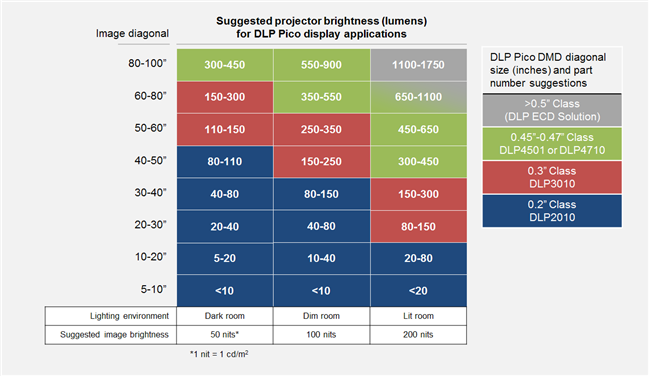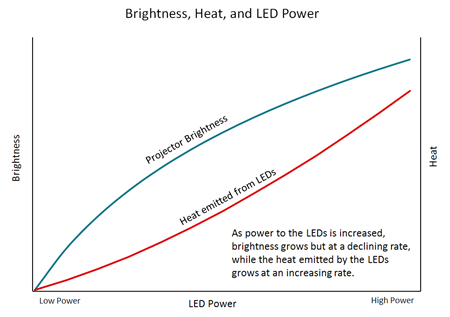SSZTBG7 March 2016 DLP230NP
Jesse Richuso
Two of the most frequently asked questions we receive from customers who are new to integrating TI DLP® Pico™ display technology are:
- How much brightness (measured in lumens) do I need for my application?
- How much brightness can be achieved, given my engineering constraints?
Brightness [1] is a seemingly simple specification. But how much brightness is required for a given pico projection application -- and the engineering tradeoffs involved in achieving higher brightness -- are more complex topics.
How Much Brightness Do I Need?
How bright a pico projection system needs to be for a given end equipment depends mainly on three factors:
- Screen size
- Image brightness required (measured in cd/m2 or nits)
- Ambient lighting environment
The bigger the screen size and brighter the desired image, the more projection brightness is typically required. In addition, the ambient lighting environment can drastically impact the brightness required to achieve the desired screen size. Figure 1 suggests projector brightness levels and DLP chipsets when taking into account various screen sizes and ambient lighting environments that users might encounter when designing their products with DLP pico projection.
 Figure 1 Suggested Projector Brightness
for a Combination of Image Sizes and Ambient Brightness Levels
Figure 1 Suggested Projector Brightness
for a Combination of Image Sizes and Ambient Brightness LevelsHow Much Brightness Can Be Achieved?
To address the question of how much brightness can be achieved, it is important to understand key variables that can be changed at a system design level, as illustrated in Table 1. To make a brighter LED projection solution, it is necessary to increase some of these variables:
| Variable | Contribution | Limitation |
|---|---|---|
| LED size | Amount of light that can be generated | LED thermal limit |
| Optics size | Amount of light that can be collected | Size and cost |
| DLP chip size | Amount of light that can be reflected | Cost |
| LED current | LED brightness level | LED thermal limit |
| Thermal solution | Amount of heat dissipated from the LEDs | Size and thus cost |
To better understand these variables, we will explore an optical module.
![Example of an Optical Module
(DLP Digital Micromirror Device [DMD], RGB LEDs, Optics, Chassis, and LED Heat
Sinks) GUID-978DBA43-CE2A-4DB1-A53F-3AB46B1ADCED-low.jpg](/ods/images/SSZTBG7/GUID-978DBA43-CE2A-4DB1-A53F-3AB46B1ADCED-low.jpg) Figure 2 Example of an Optical Module
(DLP Digital Micromirror Device [DMD], RGB LEDs, Optics, Chassis, and LED Heat
Sinks)
Figure 2 Example of an Optical Module
(DLP Digital Micromirror Device [DMD], RGB LEDs, Optics, Chassis, and LED Heat
Sinks)TI sells a variety of DLP Pico chipsets to third party companies who in turn design and manufacture optical modules and make them available to product developers. These optical modules typically include a DMD, RGB LED illumination and optics. Different optical module models may have different brightness capabilities depending primarily on the combination of DMD size, LED size and optical throughput. A given optical module can also vary in brightness depending on the power applied to the LEDs.
If power is applied to the optical module’s LEDs -- and video content sent to the DLP controller chip -- the optical module projects an image. As illustrated in Figure 3, when power to LEDs is increased, brightness grows but at a declining rate; meanwhile, the heat emitted by the LEDs grows at an increasing rate.
 Figure 3 How Increasing LED Power
Impacts Brightness and Heat Emitted
Figure 3 How Increasing LED Power
Impacts Brightness and Heat EmittedTI recently published an application note exploring this topic in more detail, entitled TI DLP Pico System Design: Brightness Requirements and Tradeoffs. In addition, TI has created a downloadable brightness and throw ratio calculator tool. Both of these complementary resources can help developers and brands integrating DLP Pico technology in their products better understand the requirements and tradeoffs to optimize projection brightness.
#Dummy#
[1] For the purposes of this blog post, brightness is defined as measured brightness, or the actual light output of a projector.